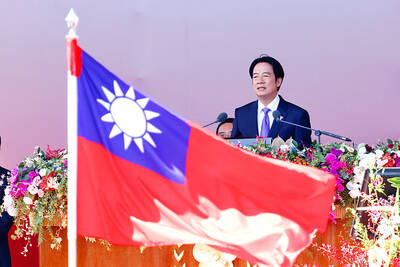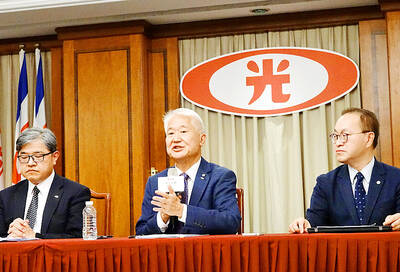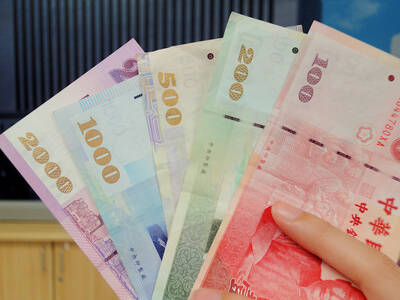Asian currencies gained last week, led by South Korea’s won, as data indicated regional exports are improving as a global recession abates.
The won snapped a three-week losing streak as overseas investors bought more Korean stocks than they sold on each of the five days and a government report showed the nation’s overseas sales fell last month by the least since October.
The won strengthened 1.5 percent to 1,265.90 per dollar in Seoul from a week ago, according to data compiled by Bloomberg.
The New Taiwan dollar reached a three-week high after China’s manufacturing expanded for a fourth month last month, boosting the outlook for trade with Asia’s second-largest economy.
The NT dollar gained 0.1 percent for the week to NT$32.89 against the greenback.
“Given the improvements we’re seeing fundamentally from the trade account side, the won is getting more attractive in real valuation terms,” said Daniel Hui, a Hong Kong-based foreign-exchange strategist at HSBC Holdings PLC. “Some of the data recently were positive. As you get more of these stabilizing factors, volatility should go down.”
The NT dollar pared a weekly advance on speculation the central bank intervened to prevent gains from hurting exporters. The currency rallied on Thursday to the strongest level since June 11 after the government opened 100 industries and infrastructure projects to investors from China.
India’s rupee climbed 0.5 percent to 47.89 and the Philippine peso advanced 0.4 percent to 48.095.
Elsewhere, the Chinese yuan was little changed this week at 6.8324 against the US currency, while Singapore’s dollar advanced 0.1 percent to S$1.4535. Thailand’s baht fell 0.1 percent to 34.08, while Indonesia’s rupiah climbed 0.3 percent to 10,190.
The US dollar rose against the euro in the pat week as speculation the economic recovery is faltering boosted demand for the safety of the US currency.
The Dollar Index, which tracks the currency against six major US trading partners, advanced to near the highest in a week after a report showed US employers cut more jobs last month than economists forecast.
The pound had its first weekly loss in a month after a report showed UK service industries were little changed last month as the recession persisted.
The greenback advanced 0.5 percent to US$1.3984 per euro as of 2:08pm in New York on Friday, from US$1.4056 at the end of last week. It reached US$1.3929 on Friday, the strongest level since June 25.
The yen was at ¥134.27 per euro, from ¥133.85 a week earlier. The US currency rose 0.9 percent to ¥96.00.
The pound was at US$1.6328, for a weekly decline of 1.2 percent. The UK currency declined 0.3 percent in the week to ¥156.77, after reaching the weakest level since June 25.

People can preregister to receive their NT$10,000 (US$325) cash distributed from the central government on Nov. 5 after President William Lai (賴清德) yesterday signed the Special Budget for Strengthening Economic, Social and National Security Resilience, the Executive Yuan told a news conference last night. The special budget, passed by the Legislative Yuan on Friday last week with a cash handout budget of NT$236 billion, was officially submitted to the Executive Yuan and the Presidential Office yesterday afternoon. People can register through the official Web site at https://10000.gov.tw to have the funds deposited into their bank accounts, withdraw the funds at automated teller

PEACE AND STABILITY: Maintaining the cross-strait ‘status quo’ has long been the government’s position, the Ministry of Foreign Affairs said Taiwan is committed to maintaining the cross-strait “status quo” and seeks no escalation of tensions, the Ministry of Foreign Affairs (MOFA) said yesterday, rebutting a Time magazine opinion piece that described President William Lai (賴清德) as a “reckless leader.” The article, titled “The US Must Beware of Taiwan’s Reckless Leader,” was written by Lyle Goldstein, director of the Asia Program at the Washington-based Defense Priorities think tank. Goldstein wrote that Taiwan is “the world’s most dangerous flashpoint” amid ongoing conflicts in the Middle East and Russia’s invasion of Ukraine. He said that the situation in the Taiwan Strait has become less stable

CONCESSION: A Shin Kong official said that the firm was ‘willing to contribute’ to the nation, as the move would enable Nvidia Crop to build its headquarters in Taiwan Shin Kong Life Insurance Co (新光人壽) yesterday said it would relinquish land-use rights, or known as surface rights, for two plots in Taipei’s Beitou District (北投), paving the way for Nvidia Corp to expand its office footprint in Taiwan. The insurer said it made the decision “in the interest of the nation’s greater good” and would not seek compensation from taxpayers for potential future losses, calling the move a gesture to resolve a months-long impasse among the insurer, the Taipei City Government and the US chip giant. “The decision was made on the condition that the Taipei City Government reimburses the related

FRESH LOOK: A committee would gather expert and public input on the themes and visual motifs that would appear on the notes, the central bank governor said The central bank has launched a comprehensive redesign of New Taiwan dollar banknotes to enhance anti-counterfeiting measures, improve accessibility and align the bills with global sustainability standards, Governor Yang Chin-long (楊金龍) told a meeting of the legislature’s Finance Committee yesterday. The overhaul would affect all five denominations — NT$100, NT$200, NT$500, NT$1,000 and NT$2,000 notes — but not coins, Yang said. It would be the first major update to the banknotes in 24 years, as the current series, introduced in 2001, has remained in circulation amid rapid advances in printing technology and security standards. “Updating the notes is essential to safeguard the integrity